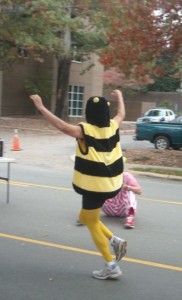
With few exceptions, I experience what I write about. It makes it easier to describe the experience. It also makes it easier to sniff out the potential BS factor. This comes in especially handy when writing about new fitness trends and classes. It came in handy a couple weeks back when I started reporting a story on Chi Running for the Charlotte Observer and The News & Observer.
I was especially intrigued by this assignment because I am a runner. The type of runner for whom Chi Running is intended. Some quick and hopefully not boring background.
One December morning in 1977 I woke up, rolled out of bed and discovered I weighed more than 200 pounds, about 40 pounds more than I weighed three years earlier in high school. I put on some sweats (they still fit), laced up my neglected Chuck Taylor All-Stars and went for a run. A short run. The next morning I did the same, running ever so-slightly farther. By that summer I was running five miles a day, weighed 155 and invested in a pair of Nike Waffle Trainers. For the next decade, I was a runner, focusing on 10Ks, usually finishing in just over 40 minutes.
When I hit 30, those years of 30-mile weeks using the then-popular heel-strike approach — encouraged by a succession of cush, fat-heeled running shoes — had taken their toll. My knees hurt, my back made getting out of the car a 10-minute ordeal. I switched to swimming and later cycling. Both fulfilled my basic fitness needs, but I desperately missed the endorphin rush that came with running.
Then, in 2009, I like so many other lapsed runners, picked up Christopher McDougall’s “Born to Run.” McDougall, too, was an injured runner. But he refused to give up despite his doctors’ insistence, so he set out on a quest to find out why some people could run forever but not others. What he found was that the run-forever-set had not been lured by the shoe companies into a heel-strike approach accommodated by $100 shoes. The minimalist, injury-free, mid-strike revolution began, and I was at the forefront, burning my plush running shoes, spieling the minimalist doctrine to anyone who would listen, running 5Ks and ramping up to my first half marathon and 20-mile trail race.
“Born to Run” had revived my running career but it had not made me immune to injury. I had an IT band injury in late 2010 completely sidelined me for four months; it was a good six before I felt comfortable racking up mileage. Chastened, I cut back.
Then, at the beginning of this month, I spent an hour with Pat Reichenbach. Pat was a gymnast in college, always enjoyed running as part of her fitness regimen, but eventually fell victim to the pursuit’s niggling injuries. Time passed, she heard about Chi Running, she took a clinic, she started running again, she became certified and started teaching the technique. Much to the amusement of patrons of the Whole Foods on Wade Avenue, she gave me an impromptu clinic on the sidewalk out front. What she showed me made immediate sense (at least the parts I understood; some of it is physiologically beyond my mental reach). I started incorporating it into my runs.
In the subsequent interviews I did for the story, with runners who had been through a Chi Running clinic, I could almost anticipate what they were going to say before they said it. My infatuation after just a couple weeks was understandable. These runners had been at it for at least two years — and they were still ardent followers. Granted, I had gotten their names from their instructors, who weren’t likely to refer clients for whom Chi Running didn’t take. But these were dedicated runners, people who took the time to learn the system, practice it, stick with it. And at least two years later it was providing the promised results: injury-free running with better performance.
I won’t go into specifics about Chi Running — you’ll have to wait for the story to appear in both papers on Tuesday (and if you don’t have access to the Observers, I will rerun it in this space Wednesday). I will tell you, though, that even with a rudimentary one-hour introduction I’m noticing a difference. I’ve run three times already this week and plan to head over to Umstead State Park for a 5 1/2-mile run when I finish here.
If you’re an injury-riddled runner, if you’re a lapsed runner, if you like the notion of running but have shied away because of the threat of injury, read the story next week. While I like to think that all of my stories are helpful, this one really could be. So block out a couple minutes on Tuesday. It might just make a difference.